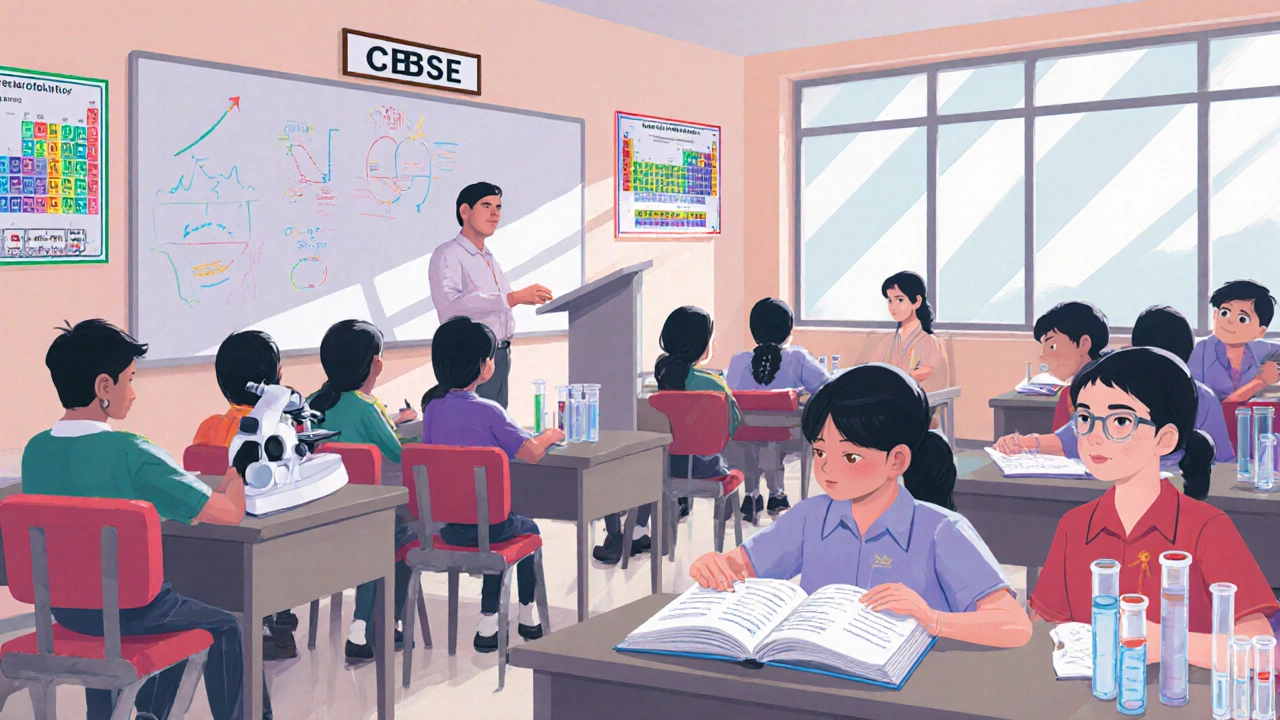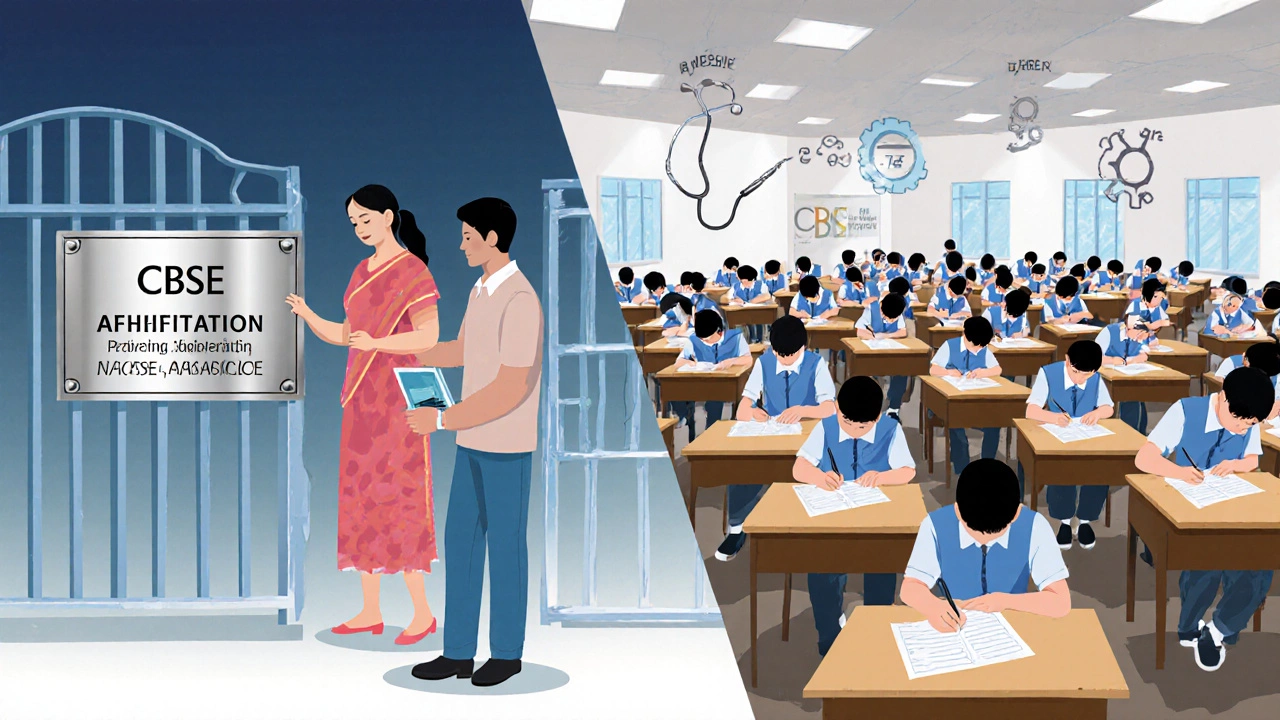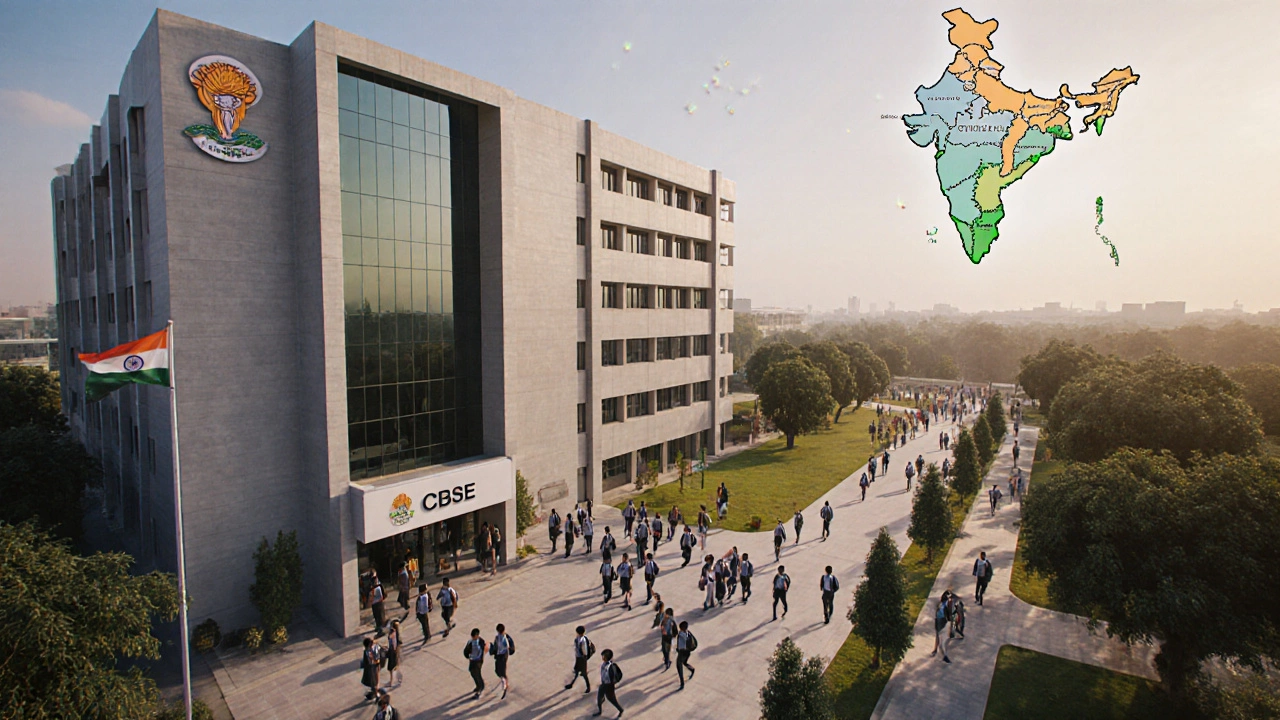CBSE School Affiliation Checker
Check School Affiliation
Verify if a school's CBSE affiliation number is valid. The format should be a 6-7 digit number (e.g., 1234567).
Key Takeaways
- CBSE stands for Central Board of Secondary Education - a national board that sets curriculum and exams for millions of schools across India.
- CBSE schools follow the NCERT syllabus, focus on conceptual learning, and prepare students for AISSE (10th) and AISSCE (12th) exams.
- Affiliation is granted by the board; each school gets a unique affiliation number and must meet infrastructure and teacher‑qualification norms.
- Compared with ICSE and State boards, CBSE offers a more uniform curriculum and is closely aligned with national entrance exams like NEET and JEE.
- Choosing a CBSE school involves checking affiliation, reviewing facilities, and understanding the fees and admission timeline.
Parents, students, and educators often ask, “What are CBSE schools in India?” The answer goes beyond a simple label - it touches on how the country's most widely used school board structures learning, assessment, and even college preparation. This guide breaks down the definition, core features, exam system, and practical steps to identify and enroll in a CBSE‑affiliated school.
What Is CBSE?
CBSE is the Central Board of Secondary Education, a national education authority under the Ministry of Education, Government of India. Founded in 1962, it standardizes curriculum, conducts board examinations, and grants affiliation to schools across 30+ states and union territories.
Because CBSE operates at the national level, its policies apply uniformly, unlike the fragmented state‑board systems where textbooks and exam patterns can vary dramatically from one state to another.
How CBSE Schools Operate
Every school that calls itself a CBSE school must be officially affiliated with the board. The affiliation process involves:
- Submitting an application with details about infrastructure, laboratories, libraries, and qualified teachers.
- Ensuring the school follows the NCERT National Council of Educational Research and Training syllabus for all subjects.
- Receiving a unique affiliation number, displayed on the school’s signage and website.
- Undergoing periodic inspections to retain affiliation.
Curriculum-wise, CBSE emphasizes a conceptual, application‑oriented approach. Subjects are divided into three streams in senior secondary (11th‑12th): Science, Commerce, and Humanities. The board also offers vocational courses and skill‑based electives, giving students flexibility beyond the core subjects.

CBSE Board Exams: AISSE and AISSCE
The two major board examinations are:
- AISSE - All India Secondary School Examination, taken at the end of 10th grade.
- AISSCE - All India Senior School Certificate Examination, taken at the end of 12th grade.
Both exams are conducted in March‑April each year and are scored on a 100‑point scale per subject. Results are released online and are the primary criteria for admission into higher secondary schools, junior colleges, and many professional courses.
Because the AISSE/AISSCE syllabi match the NCERT textbooks, students also get a head start on national entrance exams like NEET (medical) and JEE (engineering). This alignment is a key reason many parents prefer CBSE schools.
How to Identify a Legitimate CBSE School
Not every school that uses the term "CBSE" is officially affiliated. Here’s a quick checklist:
- Look for the board’s affiliation number on the school’s front‑gate or website. It usually follows the format “Affiliation No. 1234567”.
- Visit the official CBRS portal (cbseschool.gov.in) and verify the number against the database.
- Confirm that the school follows the NCERT curriculum - request a copy of the syllabus or sample textbooks.
- Check for regular teacher‑training programs organized by CBSE or NCERT.
- Ensure the school conducts internal assessments that mirror the board’s Continuous and Comprehensive Evaluation (CCE) framework.
These steps help avoid “pseudo‑CBSE” institutions that may not meet the board’s quality standards.
CBSE vs. Other Boards - A Quick Comparison
| Aspect | CBSE | ICSE | State Board |
|---|---|---|---|
| Governing Body | Central Board of Secondary Education | Council for the Indian School Certificate | State Education Departments |
| Curriculum Source | NCERT textbooks (national) | ICSE board‑specific textbooks | State‑specific textbooks |
| Exam Focus | Conceptual understanding, problem solving (aligned with NEET/JEE) | Depth of knowledge, language proficiency | Varies; often more rote learning |
| National Entrance Exam Alignment | Strong (NEET, JEE, UPSC prelims) | Moderate (some subjects overlap) | Weak or inconsistent |
| Geographic Reach | All India + many overseas schools | Mostly urban private schools | Primarily within the respective state |
For families that plan to move between states or aim for national competitive exams, CBSE usually offers the smoothest transition. However, ICSE can be a better fit for students who thrive on detailed literature study and want a more rigorous English component.

Admission Process and Fees
Enrolling in a CBSE school typically follows these steps:
- Obtain the school’s admission brochure and note the cut‑off dates (many schools have two rounds - early and regular).
- Submit the application form along with documents: birth certificate, previous school records, address proof, and passport‑size photographs.
- Pay the non‑refundable application fee (usually INR500‑1,500).
- Attend a personal interview or written test if the school requires one (common for higher classes).
- Once admitted, pay the first‑semester tuition, which varies widely - from INR25,000 in government‑aided schools to over INR1,50,000 in elite private CBSE institutions.
- Complete enrollment by submitting the affiliation proof, fee receipt, and any additional documents requested by the school.
Many CBSE schools also offer scholarship schemes for meritorious or economically weaker students, so it’s worth asking the admissions office about eligibility.
Benefits and Drawbacks of CBSE Schools
Benefits
- Uniform syllabus across the country makes transfers easy.
- Strong alignment with national entrance exams (NEET, JEE) improves preparation.
- Emphasis on analytical skills and continuous assessment reduces high‑stakes pressure.
- Wide network of schools, including many affordable government‑aided options.
Drawbacks
- Curriculum can be perceived as less intensive in literature and social studies compared to ICSE.
- Heavy focus on science and mathematics may limit exposure to arts in some schools.
- Quality varies; while top CBSE schools are excellent, some affiliated schools may have limited resources.
Weighing these pros and cons against your child’s learning style, future goals, and geographic stability will help you decide if a CBSE school is the right fit.
Frequently Asked Questions
How can I verify a school's CBSE affiliation?
Visit the official CBSE website, locate the "Affiliation Search" section, and enter the school's affiliation number. The portal will display the school's status, year of affiliation, and authorized classes.
What is the difference between AISSE and AISSCE?
AISSE is the 10th‑grade board exam that assesses foundational knowledge across core subjects. AISSCE is the 12th‑grade exam, focusing on the chosen stream (Science, Commerce, Humanities) and serving as the primary eligibility criterion for university admissions.
Do CBSE schools follow the same textbooks nationwide?
Yes. All CBSE schools use textbooks published by the NCERT, which are released centrally each year. This ensures uniform content regardless of the school’s location.
Are private CBSE schools more expensive than government‑aided ones?
Generally, private CBSE schools charge higher tuition, often ranging from INR50,000 to INR1,50,000 per year, while government‑aided CBSE schools may charge nominal fees, sometimes as low as INR5,000‑10,000 annually.
Can I switch from a State board school to a CBSE school mid‑year?
Switching is possible but challenging. You’ll need to clear an assessment test and align your previous grades with the CBSE curriculum, often repeating the current class to meet board standards.
